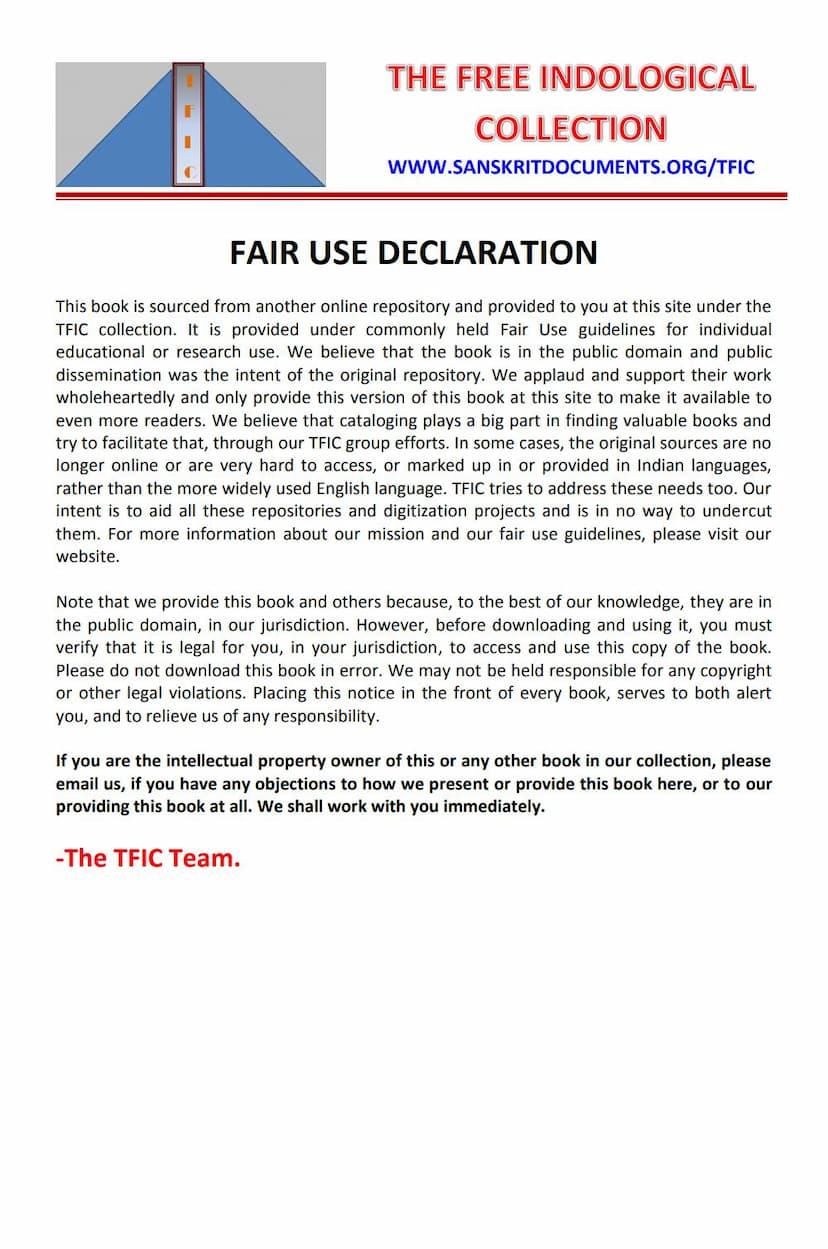Jain Siddhant Pravesh Ratnamala 08
Added to library: September 2, 2025

Summary
This Jain text, "Jain Siddhant Pravesh Ratnamala 08" by Digambar Jain Mumukshu Mandal Dehradun, is a comprehensive guide designed to introduce readers to fundamental Jain principles, particularly focusing on the concepts explained in the "Chhēḍālā" (Six Sections/Canters) and other key Jain philosophical texts. The book is structured around a question-and-answer format, making complex doctrines accessible.
Here's a breakdown of its content based on the provided index and pages:
Core Jain Principles and Concepts:
- The Soul (Jīva) and Non-Soul (Ajīva): A significant portion of the book is dedicated to clarifying the nature of the soul and non-soul, explaining how one can err in understanding these fundamental tattvas (realities). This involves analyzing misapprehensions related to each of the seven tattvas.
- Bondage (Bandha) and its Types: The text elaborates on the concept of bondage, distinguishing between:
- Jīva Bandha: Bondage of the soul.
- Pudgala Bandha: Bondage related to material substances.
- Ubaya Bandha: Combined bondage involving both soul and matter. It meticulously analyzes sentences and phrases to identify and explain these types of bondage through questions and answers.
- The Six Sections (Chhaēḍālā): The book heavily references and explains the "Chhaēḍālā," a foundational text in Jainism that systematically outlines the path to liberation. It analyzes the mistakes (bhūl) an individual makes regarding each of the seven tattvas as presented in the first and second sections of the Chhēḍālā.
- Right Faith, Right Knowledge, and Right Conduct (Samyakdarshan, Samyakjñān, Samyakchāritra): These are presented as the core components of the path to liberation (Moksha Mārga). The text emphasizes that without Right Faith, knowledge and conduct are considered false.
- Nischaya and Vyavahāra Nayas (Viewpoints): A crucial aspect of Jain philosophy is understanding the two primary viewpoints:
- Nischaya Naya (Real Viewpoint): Focuses on the ultimate, unchanging reality of the soul's pure nature.
- Vyavahāra Naya (Conventional Viewpoint): Deals with the worldly and relative aspects, including the soul's interaction with karma and the body. The book dedicates extensive question-and-answer sections to clarifying these two perspectives and how they are applied to various spiritual stages (guṇasthānas).
- The Seven Tattvas: The text delves into the correct understanding of the seven essential tattvas: Jīva (Soul), Ajīva (Non-soul), Āsrava (Influx of karma), Bandha (Bondage), Saṁvara (Stoppage of karma), Nirjarā (Shedding of karma), and Moksha (Liberation). It identifies and explains the misconceptions related to each.
- The Nature of the Self: The book explores the true nature of the soul as an eternal, unchanging, conscious entity, distinct from the physical body and karmic influences. It highlights the importance of self-realization and dwelling in one's true nature.
- The Greatness of Pure Usage (Shuddhopayoga): The text emphasizes that pure spiritual exertion (Shuddhopayoga) is the direct path to liberation, originating from the fourth stage of spiritual development.
- The Importance of True Knowledge: It stresses that true liberation comes from understanding the reality of things as they are, not through mere intellectual knowledge or adherence to rituals without proper understanding.
- The Nature of Attachment and Detachment: The book addresses how attachments to worldly possessions, relationships, and even one's own body lead to suffering, while detachment and focusing on the soul's true nature lead to peace and liberation.
- The Cycle of Birth and Death (Sansāra): It explains how ignorance and wrong beliefs lead to the soul's transmigration through various life forms and realms, emphasizing the human birth and Jain Dharma as precious opportunities for liberation.
- The Goal of Liberation (Moksha): The ultimate aim is to shed all karmic bonds and attain the state of pure, omniscient, blissful soul, residing in the highest spiritual realm.
Key Themes and Teaching Methods:
- Question and Answer Format: The book extensively uses a Q&A format to break down complex philosophical concepts. This pedagogical approach aims to clarify doubts and provide direct answers to potential learner queries.
- Illustrative Examples and Analogies: The text likely uses various examples and analogies, as seen in the poetic verses on pages 4 and 5 describing the decline of youth and old age, to make the spiritual journey relatable and understandable.
- Emphasis on Correct Understanding: A recurring theme is the identification and correction of "bhūl" (mistakes or errors in understanding) regarding Jain principles.
- Role of Scripture: The book frequently references and draws explanations from key Jain scriptures like "Chhaēḍālā," "Moksha Mārg Prakashak," and "Samaysār."
- Stages of Spiritual Development (Guṇasthānas): The text likely touches upon the fourteen stages of spiritual progress, explaining how the understanding of Nischaya and Vyavahāra Nayas evolves through these stages.
- The Nature of Devotion: The book discusses the correct approach to devotion, emphasizing that true devotion is directed towards the liberated souls (Siddhas and Arhats) and the path they illuminated, not mere ritualistic worship without inner understanding.
- The Importance of Human Life: It highlights the rarity and significance of a human birth, especially one within the Jain tradition, as the opportune moment for spiritual practice.
Overall Purpose:
"Jain Siddhant Pravesh Ratnamala 08" serves as an educational resource aimed at providing a systematic and in-depth understanding of core Jain philosophical tenets. By using a question-and-answer format and referencing authoritative scriptures, it guides individuals toward correct belief (Samyakdarshan), right knowledge (Samyakjñān), and right conduct (Samyakchāritra), ultimately leading to spiritual liberation.